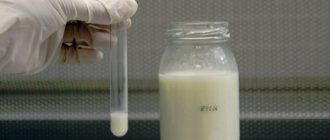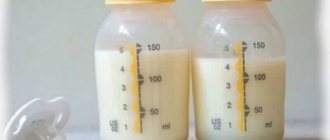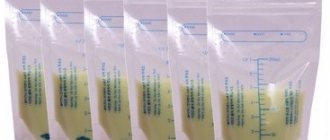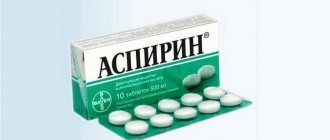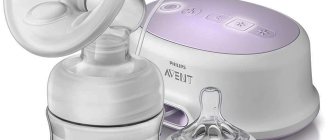Mother's milk contains everything the baby needs for full development. Nutrients, vitamins, and microelements that enter the mother’s body are partly excreted along with breast milk and enter the baby’s body when it needs them. Breastfeeding women, along with the happiness of motherhood, are concerned about a number of issues regarding breastfeeding. They relate to how long it takes for breast milk to replenish.
Characteristics of natural nutrition for a child
A baby can fully gain weight and develop only if his body receives a sufficient amount of nutrients. Due to its harmonious composition, this product entails:
- simple and instant assimilation;
- the child receives the required amount of vitamins and microelements;
- formation of beneficial microflora in the intestinal lumen;
- maintaining immune function;
- creating resistance to pathologies;
- providing the basis for the intellectual and physical development of the baby.
Potentially Hazardous Products
The dangers of alcohol and tobacco are known to everyone, but not everyone can give them up. A nursing mother can cause incredible harm to her baby by drinking alcohol and smoking.
There are other ingredients that will not benefit the baby.
Medicines
Before using any medicine, it is better to consult your doctor. The drug should be taken only if the harm it causes to the baby is justified.
After the time indicated on the package has passed, it is necessary to pump and only then put the baby to the breast.
Nicotine and alcohol
Nicotinic acid and alcohol enter the mother’s blood in a short time, literally a few minutes. Mild dizziness is the first and clear sign that the substance is in the woman’s blood. However, each mother is individual, and therefore the following should be taken into account:
- Her weight;
- Strength of the drink or tobacco;
- Features of metabolism.
These components can remain in the female body for up to several days. They remain in the baby’s body for the same amount of time, which has an extremely adverse effect on his further development.
It is unacceptable to regularly consume alcohol-containing products and resort to cigarettes so as not to harm the health of the baby.
Sugar
Sweets enter the blood within 10 minutes and can be eliminated within half an hour. However, this does not mean that mother can eat sweets in unlimited quantities. Sugar is also quickly absorbed into milk, and with it into the child’s body. The gastrointestinal tract of young children is poorly developed and is not able to cope with large amounts of sweet milk, which leads to bloating.
Gas-forming foods
The main components that contribute to the formation of gases in the body are:
Their proteins can enter the baby’s body along with mother’s milk. They always cause an upset baby's tummy. Therefore, it is better for a nursing woman to avoid using them. Or try these products in a minimal amount and carefully observe the baby’s reaction.

Despite its many challenges, breastfeeding is an incredible opportunity to enjoy bonding with your baby.
How does milk production occur?
You should also determine where the milk in the breast comes from and how it comes out. Breast enlargement begins during pregnancy. This indicates that the body has begun to prepare for breastfeeding. The main factor that provokes breast enlargement is the growth of glands that are responsible for the production of “baby food”. Therefore, the amount of milk secreted in no way depends on the size of the breast.

Understanding the principle of formation of colostrum and milk will allow you to find out how this product is formed. The mammary glands are peculiar lobules located deep in the chest. They are the ones responsible for milk production. Subsequently, this fluid enters the milk ducts and flows to the nipples, where there are exits. That is why when feeding there is a requirement that the baby must cover the entire space around the nipple with his mouth.
When a baby suckles at the breast, it stimulates the nerve endings in the nipple. They, in turn, send a signal to the brain, in particular to the pituitary gland. As a result, oxytocin and prolactin are produced. It is due to these hormones that further milk production is observed in the amount that the baby needs for full development.
Duration of absorption of fresh foods
A nursing mother's daily diet should include fresher and more varied food. Eating monotonous food is not allowed.
This is due to the fact that the child may not receive enough valuable vitamins, and daily repeated meals lead to the accumulation of the same substances, which may not always be useful.
Every woman who has a breastfed child should receive daily:
However, this list can cause allergies or gastrointestinal upset in the baby. To prevent this from happening, you need to know the rates of absorption of substances into the mother’s blood and milk.
That is, if a mother wants to treat herself to something harmful to the child, then the baby should be fed immediately after eating. It will not yet have time to get into the blood and milk, and accordingly, it will not be transmitted to the child.
It is important to understand that the processed substances in milk are retained as long as it is in the alveoli. If the mother expresses herself immediately after eating dangerous foods, the rate of their absorption increases several times.
Taking into account the fact that milk can quickly renew, the baby will receive nutrition of little value in at least 60 minutes.
If the mother has eaten something harmful, then it is recommended to express no earlier than after 180 minutes. In order for beneficial microelements to enter the child’s body faster, you can express yourself immediately after eating.
Colostrum is the baby's first milk
But how is breast milk renewed? Let's look at this process in more detail. First of all, colostrum is produced. It looks like milk, but has a rich and buttery consistency, containing everything a child needs to fully adapt to new conditions. It may completely end on the first day of feeding, but in an ideal situation it should be enough for 3 days, after which milk will begin to be released. The first type of food is higher in calories, so a small amount is required to satiate. Regular milk is not so fatty, but it is also produced in large volumes.
Application of sorbents
When consuming carbonated drinks, baked goods, and legumes, stomach problems often occur for both mother and baby. There is bloating in the abdomen, a feeling of heaviness and other unpleasant consequences.
In this case, it is possible to accept different sorbents. To improve the well-being of a nursing woman, you can use activated carbon, and her baby can use Smecta.
In this case, you won’t have to use sorbents again and cause inconvenience to the baby.
Breastfeeding can boost your baby's immunity and speed up its growth. Every mother should make this process painless for the baby. To do this, it is better to give up junk food at least until complementary foods are introduced.
What types of breast milk are there?
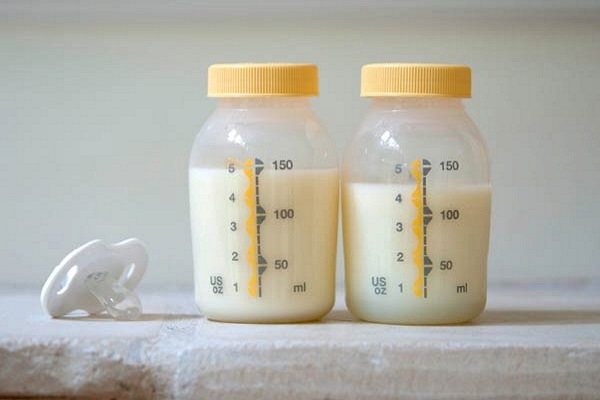
We have looked at how milk is renewed; all that remains is to study how long it takes for this to happen. First you need to decide on the types of milk existing in a woman’s breast.
- Foremilk. It contains a lot of protein, is transparent and light in color. To a young, inexperienced mother it may seem like it resembles water.
- Hindmilk. It has a higher calorie content and is located further from the surface of the chest. This composition is more difficult to absorb. If the baby does not receive it in large quantities, he does not eat enough and constantly cries due to increasing hunger.
Since each mother has a different composition and quantity of this milk, the renewal rate also varies.
How long does it take for food to pass into breast milk?
Nursing mothers understand that absolutely all the foods and medications they consume then pass into the milk and enter the baby’s body. But after how long are the substances absorbed into the blood and transferred to the baby during feeding?
Nutrition and milk production
- Food eaten by a nursing mother enters the stomach, is digested there and then moves further through the gastrointestinal tract. In different parts of the intestine, different enzymes act on the nutrient mass, breaking down substances into smaller and more easily digestible elements.
- The broken down elements are absorbed by the intestinal villi, enter the blood of the nursing mother and are distributed to all cells of the body. The body is “enriched” by feeding not only micro- and macroelements: along with them, traces of allergens, medications taken, etc. enter the plasma.
- During lactation, a nursing woman's body uses blood plasma. In the alveoli located in the chest, direct production of milk occurs, which then goes through the ducts of the glands to the nipple.
Milk itself has a strict, constant composition; you cannot make it fatter or further enrich it with certain elements. But the molecular trace from the food eaten by the mother is quite capable of remaining in the blood plasma and affecting the baby’s body.
So, if a nursing woman eats cabbage, after some time the baby is guaranteed to begin to suffer from gas, after beets, his stool will become thinner, and after juicy strawberries, the baby will probably be covered in a rash.
Adviсe
To protect the baby from the influence of nutrition unacceptable for breastfeeding, mothers can find out the time for complete removal of traces of products from the blood and express “into the sink”, and then wait for a new portion of milk and feed the baby with a safe lactation product.
Knowing the period of “assimilation” of products is also necessary in order to use their positive properties during breastfeeding and to provide all possible “help” to the baby with beets for constipation, and starch nutrition for a mild tendency to diarrhea.
Milk renewal occurs every 2-3 hours after the mammary gland is emptied, but you do not need to completely rely on this time period. Some foods take longer to digest and penetrate into milk, and medications can be eliminated from the blood for up to 3 days.
Absorption rate of different products
To determine exactly when you can feed your baby, you must know how quickly “food” enters breast milk and when it is finally removed from it.
Sugar
Sugar is a fast carbohydrate product, so if a nursing mother treats herself to sweets, literally after 10 minutes the element will be in the blood, but after half an hour the plasma will already be cleared of it
.
Traces of broken down sugar in the plasma can slightly change the taste of breast milk and greatly affect its effect on the baby’s body. Feeding a lactation product containing molecules of this fast carbohydrate will lead to bloating in the baby's tummy and can cause a skin rash.
Cabbage, legumes and grapes
These foods are known to promote gas. This property of food is transmitted through milk to the infant. The protein molecules of these products enter the baby’s body, and his digestive system reacts to their presence with increased gas formation.
In order not to torment the child, it is better to completely stop eating gas-forming products, especially in the first 3-4 months of the baby’s life. If you had to eat cabbage soup, feed the baby immediately after your meal, while digestion has not yet begun, and stretch out the time until the next feeding as much as possible so that your blood is a little cleared of unnecessary elements.
Medicines
You can read about the rate of absorption and complete elimination of medications from the blood in the instructions for the specific drug you are taking.
If any specialist prescribes drug therapy for you, be sure to ask whether taking these drugs is allowed for breastfeeding. Just in case, consult your pediatrician about the possibility of breastfeeding during treatment.
It may be better for you to temporarily switch the baby to formula until your treatment ends, and to maintain lactation regularly, according to the established feeding schedule, express “into the sink.”
Source: https://NewBabe.ru/pitanie/kogda-eda-popadaet-v-grudnoe-moloko.html
How does breast milk renew itself?
When mommy has eaten, the mechanism of her body begins to process all the incoming substances. It sends something into the blood, delivers something to the internal organs, and utilizes something. Traditionally, after 9 hours, all the substances consumed by the mother the day before appear in breast milk.
But how often does this nutrition update for a child occur? The answer is obvious - all the time. The fact is that the process of producing food for a child is continuous, so it does not stop for a minute. If the breastfeeding regimen is chosen optimally and is not disturbed by any other factors, the milk does not stagnate, but leaves the body in a timely manner, and new liquid is formed in its place. At the same time, the high-quality composition of the food is completely adapted to the baby’s needs.
How quickly do changes happen? Already in the 4th month of feeding, there is an increase in the level of calcium in breast milk, as well as other substances that are needed to strengthen bone structures. A little later, there is a significant increase in the amount of protein that is needed for muscle development. At different times, the liquid undergoes changes in the level of certain elements it contains.
Thus, answering the question of how long it takes for the natural food for the child to be renewed in the mother’s body, it will be as follows: this is observed every minute. This fact can be explained by the fact that milk meets the general and specific needs of the baby, and therefore needs constant replenishment and renewal.
How does a mother's food affect the quality of her milk?
It is generally accepted that you can change the consistency of breast milk if you consume certain foods.
Mothers think that foods high in fat or with polyunsaturated acids increase the fat content of milk.
And vice versa, if you eat only lean foods, then milk will become dietary.
This is not true, you should not believe such statements.
People who claim this are not familiar with the physiology and process of milk production.
But in any case, mother’s milk is the best and healthiest food for a baby!
This is due to physiological processes and developmental characteristics of the body.
Nutrition can only slightly influence the consistency of breast milk.
We answered this question in detail and also posted materials:
We recommend that you familiarize yourself with them.
It is important to understand that the female body produces exactly the kind of milk that a born baby needs.
If you put a baby to the breast of someone other than your own mother, problems may arise in the form of gastrointestinal disorders.
[expert_bq nutrition is the key to the proper development of the body. In order for the baby to grow well, the mother needs to eat properly.
Daily food should include fruits, vegetables, cereals, dairy products, meat and fish.
In this way, the child will receive many vitamins and beneficial microelements necessary for development.[/expert_bq]
What determines the speed of production?
Some doctors say that the more the breast is emptied during breastfeeding, the faster it fills with breast milk. But studies have not confirmed this fact. Milk does not accumulate in the mammary glands indefinitely, since each breast has its own capacity. This figure has been measured in several women and it has been found that it can range from 80 to 600 ml. Therefore, the rate of production most often depends on the quality of the mother’s diet, the characteristics of her body and the true needs of the baby.
So we looked at how breast milk is renewed, and after how many hours substances from the food consumed the day before end up in the baby’s food. The renewal process is endless and unlimited, so milk is subject to it every day, every minute, every second.

- Related Posts
- How quickly breast milk burns out: causes and consequences
- How to warm up breast milk: methods
- How and where is breast milk produced?
« Previous entry
Potentially Hazardous Products
During breastfeeding, a nursing woman is given responsibility not only for herself, but also for the child. It is impossible to determine in advance how a baby may react to the mother’s lifestyle. Some babies are prone to allergies, while others do not have this feature.

Certified breastfeeding consultant, famous video blogger Nina Zaichenko says:
— The mother’s diet during lactation should be varied. Vitamins and microelements will still get into the milk from the woman’s body, but if she adheres to a strict diet, then they will have nowhere to be replenished. This threatens vitamin deficiency, deterioration of the condition of teeth and bones, as well as other problems.
A responsible mother pays a lot of attention to her nutrition during lactation. After all, it is food during this period that becomes the main source of vitamins and minerals. It is recommended to eat healthy foods. You should not eat monotonously and adhere to a strict diet during breastfeeding. But the use of some potentially dangerous substances should be completely abandoned.
What is undesirable to eat and drink during breastfeeding:
- any drinks containing alcohol;
- coffee and its derivatives;
- carbonated drinks with dyes;
- vegetables and fruits that cause allergies (this is an individual list);
- honey and some types of nuts;
- mushrooms;
- marinades and pickles;
- exotic dishes;
- products with flavor enhancers.
Alcohol
Alcohol is absorbed into the bloodstream very quickly, within 5-10 minutes. It penetrates the mucous membrane while still in the mouth. Depending on the strength of the drink and the amount drunk, alcohol remains in the body from half an hour to several days. Ethanol penetrates into all biological fluids, including alcohol in breast milk.
There is a myth that if you express a portion of milk after drinking alcohol, it will not reach your baby. But pumping once won't help. Ethanol will still remain in the blood, from where it will continuously flow into breast milk. This will continue until the alcohol is completely eliminated from the body.
Allergenic products
Allergic reactions in children vary in intensity and differ in manifestations. Some babies have red cheeks, while others have peeling palms. Allergies can manifest as itching, redness, and swelling of the skin. Also, sometimes gastrointestinal function is disrupted in children.
Any product can cause an allergy in a child, but most often it leads to:
- honey;
- nuts;
- chocolate;
- citrus;
- milk and its derivatives;
- some types of meat;
- seafood;
- soy;
- flavor enhancers and dyes.
The allergen begins to affect the mother within 5-30 minutes. If the mother has consumed an allergenic product, the baby may experience a reaction immediately after feeding or within a few days. Allergens are eliminated within a few days.
Food does not necessarily cause such a reaction. Some babies feel well, even if the mother ate chocolate with honey and nuts the day before, and washed it down with citrus juice.
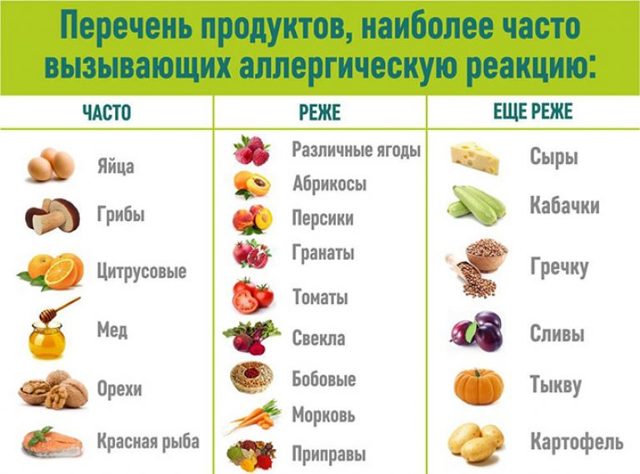
Vegetables and fruits are out of season
Fruits and vegetables should be in the diet of a nursing woman. It is important to choose seasonal fruits. They contain vitamins and microelements. Vegetables and fruits that are grown out of season (such as winter tomatoes) have little to no nutritional value left. Such foods may contain harmful substances and chemicals.
Vegetables penetrate the small intestine approximately 4 hours after eating, begin to be absorbed, and from that moment on the child can react to them. Sweet fruits are partially absorbed within half an hour.
Foods with dyes, flavor enhancers, preservatives
During the entire period of lactation, mothers are advised to refrain from consuming preservatives, marinades, various sauces, flavor enhancers and foods with harmful additives. Perhaps such food will not affect the child in any way, but few people want to risk the health of their baby. Besides, there is no benefit in such products.
How long does it take for food to pass into breast milk? And what to do if you really want something that you can’t?
Breastfeeding is a long and often difficult process that raises many questions for women.
Every mother is not averse to pampering herself with various delicacies, but their effect on the child’s body can be negative.
In order for nutrition to bring benefit and joy not only to the mother, but also to her baby, it is necessary to know how long it takes for food to enter breast milk.
How does a mother's food affect the quality of her milk?
It is generally accepted that you can change the consistency of breast milk if you consume certain foods.
Mothers think that foods high in fat or with polyunsaturated acids increase the fat content of milk.
And vice versa, if you eat only lean foods, then milk will become dietary.
This is not true, you should not believe such statements.
People who claim this are not familiar with the physiology and process of milk production.
But in any case, mother’s milk is the best and healthiest food for a baby!
Scientists have proven that each mother has her own milk fat content by nature.
This is due to physiological processes and developmental characteristics of the body.
Nutrition can only slightly influence the consistency of breast milk.
It is important to understand that the female body produces exactly the kind of milk that a born baby needs.
If you put a baby to the breast of someone other than your own mother, problems may arise in the form of gastrointestinal disorders.
Healthy nutrition is the key to proper development of the body. In order for the baby to grow well, the mother needs to eat properly.
Daily food should include fruits, vegetables, cereals, dairy products, meat and fish.
In this way, the child will receive many vitamins and beneficial microelements necessary for development.
Duration of absorption of fresh foods
A nursing mother's daily diet should include fresher and more varied food. Eating monotonous food is not allowed.
This is due to the fact that the child may not receive enough valuable vitamins, and daily repeated meals lead to the accumulation of the same substances, which may not always be useful.
Every woman who has a breastfed child should receive daily:
- Fruits;
- Vegetables;
- Nuts;
- Cottage cheese;
- Juices, fruit drinks.
However, this list can cause allergies or gastrointestinal upset in the baby. To prevent this from happening, you need to know the rates of absorption of substances into the mother’s blood and milk.
Fresh food enters the blood vessels after at least one hour. After this, the blood carries the processed substances into the milk alveoli of the breast for another 180 minutes.
That is, if a mother wants to treat herself to something harmful to the child, then the baby should be fed immediately after eating. It will not yet have time to get into the blood and milk, and accordingly, it will not be transmitted to the child.
It is important to understand that the processed substances in milk are retained as long as it is in the alveoli. If the mother expresses herself immediately after eating dangerous foods, the rate of their absorption increases several times.
Taking into account the fact that milk can quickly renew, the baby will receive nutrition of little value in at least 60 minutes.
If the mother has eaten something harmful, then it is recommended to express no earlier than after 180 minutes. In order for beneficial microelements to enter the child’s body faster, you can express yourself immediately after eating.
It is very important to establish a feeding regime that is comfortable for everyone from the first days
How quickly are allergens absorbed?
As you know, a large number of foods presented on store shelves have additives that are of little use. They cause harm to the adult body, and in small children, in addition, they can turn into allergic reactions.
The most dangerous effects on the child’s body are the following biological additives::
- Histamine (found in eggs, cheeses, sausages);
- Glutamate (added to chips, crackers);
- Cyclamate (contains chocolate and chewing gum);
- Aspirin (available in dairy products with a long shelf life).
The absorption of these substances has a very high speed - 20 minutes. This time is enough for them to penetrate into mother's milk. However, these supplements can leave the body extremely slowly, up to 1 week.
Only after seven days are harmful components marked “E” and a numerical value finally processed. Every mother needs to think carefully before consuming such products.
Nicotine and alcohol
Nicotinic acid and alcohol enter the mother’s blood in a short time, literally a few minutes. Mild dizziness is the first and clear sign that the substance is in the woman’s blood. However, each mother is individual, and therefore the following should be taken into account:
- Her weight;
- Strength of the drink or tobacco;
- Features of metabolism.
These components can remain in the female body for up to several days. They remain in the baby’s body for the same amount of time, which has an extremely adverse effect on his further development.
It is unacceptable to regularly consume alcohol-containing products and resort to cigarettes so as not to harm the health of the baby.
Gas-forming foods
The main components that contribute to the formation of gases in the body are:
- Grape;
- Cabbage;
- Carbonated drinks;
- Legumes.
Their proteins can enter the baby’s body along with mother’s milk. They always cause an upset baby's tummy. Therefore, it is better for a nursing woman to avoid using them. Or try these products in a minimal amount and carefully observe the baby’s reaction.
Despite its many challenges, breastfeeding is an incredible opportunity to enjoy bonding with your baby.
Water-soluble vitamins
Water-soluble vitamins are vital for the baby, and therefore their intake is necessary for proper development and rapid growth. The most important of them are:
- Riboflavin (found in nuts, liver, rose hips);
- Thiamine (found in beef, wheat bread and spinach);
- Pyridoxine (enters the body when eating fish, carrots, tomatoes);
- Nicotinic and ascorbic acids (they can be found in parsley, cereals and berries).
These vitamins do not accumulate in the baby’s body: they will be gone after a short time. Therefore, mother needs to eat as many ingredients as possible from the above list every day.
Iron
Iron is found not only in diet, but also in mother's milk naturally. Some children, due to their developmental characteristics, may not absorb it well. In this case, a disease such as anemia may develop. To detect it, you need to take a blood test.
If a doctor diagnoses a lack of iron in a child’s body, he prescribes special medications for mother and child , and in some cases advocates the accelerated introduction of complementary foods.
Are you sure your baby is gaining weight correctly? Compare the table of weight gain by month.
Calcium
Human milk is a natural source of calcium. The baby always receives it in the required quantities, regardless of the mother’s diet.
Sometimes the baby may take in too much calcium, and the amount remaining is not enough to maintain the normal health of the mother.
In this case, she needs to increase her daily portions of dairy products and fish.
Learn more about proper nutrition for a nursing mother in the following video:
Basic nutrition for a nursing mother
The rate at which food is processed in the gastrointestinal tract determines how quickly what is eaten enters breast milk. Using the table, let's look at the time it takes for food to be absorbed into milk.
Product Time of release into milk (hours)
| Meat | 16-18 |
| Pasta | 12-15 |
| Vegetables | 6-8 |
| Milk products | 2-3 |
It is recommended to introduce new components into the mother’s diet in the morning. This will help to timely identify the baby’s reaction to them and take appropriate measures.
Application of sorbents
When consuming carbonated drinks, baked goods, and legumes, stomach problems often occur for both mother and baby. There is bloating in the abdomen, a feeling of heaviness and other unpleasant consequences.
In this case, it is possible to accept different sorbents. To improve the well-being of a nursing woman, you can use activated carbon, and her baby can use Smecta.
Sorbents remove all harmful substances from the body. However, their frequent use cannot be justified. First of all, the mother must monitor her diet so as not to harm the baby’s health.
In this case, you won’t have to use sorbents again and cause inconvenience to the baby.
Breastfeeding can boost your baby's immunity and speed up its growth. Every mother should make this process painless for the baby. To do this, it is better to give up junk food at least until complementary foods are introduced.
This will help raise a healthy child who will not need vitamins and will always please his beloved mother. A daily variety of dishes in a woman’s diet will help to avoid problems with the development of a baby’s tummy and will make milk the most healthy.






